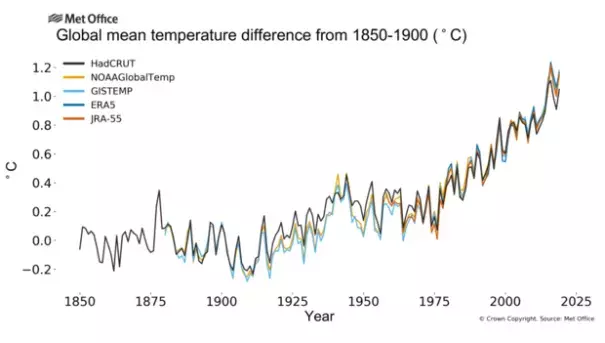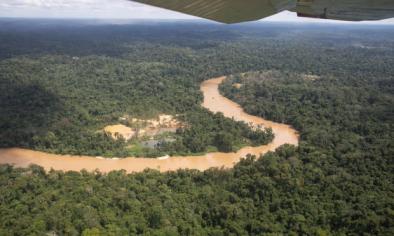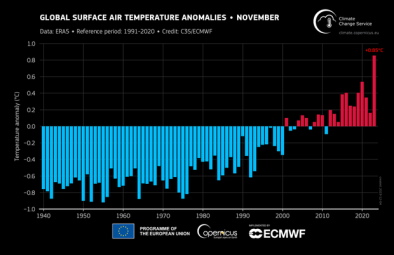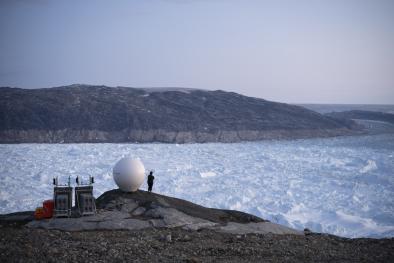UN climate report warns "time is fast running out" to avert the worst impacts of climate change

Climate Signals Summary: Climate change is increasing the frequency and/or intensity of a variety of extreme weather events, including hurricanes, wildfires, floods, heat waves, and extreme precipitation.
Article Excerpt: The United Nations' weather and climate agency is out with its annual State of the Climate report, and it says "the tell-tale physical signs of climate change" are everywhere. The report documents unprecedented heat waves, fires and floods over the past year, and warns that there is likely more to come.
In the report, the UN's World Meteorological Organization (WMO) cited the historic fires in Australia and the Amazon, record-shattering heat waves in Europe, and soaring levels of carbon dioxide in the atmosphere. In a statement released with the report, the leader of the United Nations calls climate change "the defining challenge of our time" and said "time is fast running out for us to avert the worst impacts of climate disruption."
...
More than 90% of the heat from these excess greenhouse gases is trapped in the oceans, and that has resulted in another record-breaking year for ocean heat content. Even though there was no El Nino, a climate pattern which allows ocean heat to escape into the atmosphere, 2019 still ended up being the globe's second-warmest year on record. In fact, the five warmest years on record worldwide occurred over the most recent five years.
The impact on humans is growing, with climate variability and extreme weather "among the key drivers of the recent rise in global hunger," the UN said in a press statement.
...
If there's one thing most of the planet will remember about 2019, it's the out-of-control fires. From Australia to the Amazon to California, devastating fires dominated news headlines for weeks.
...
The same mechanism that set the stage for the historic bushfire season in Australia also supercharged the heat wave which helped fuel those fires. A phenomenon called the Indian Ocean Dipole, with cool waters near Australia and warm waters near east Africa, combined with a climate system spiked by human heating to cause a record-shattering heat wave in Australia.
...
Europe also experienced two historic heat waves this past summer, in late June and late July. In France, a national record high temperature of 115 degrees Fahrenheit shattered the old record by 3.5 degrees. National records were also set in Germany, the Netherlands, Belgium, Luxembourg and the United Kingdom.
Not even Antarctica was spared from record breaking heat, with temperatures of 69 and 65 degrees Fahrenheit reported on two separate days in February. The unusual warmth is rapidly melting ice and fracturing ice shelves.
...
As mentioned above, ocean heat content (the amount of heat stored in the ocean) set a new record in 2019. While ocean waters help absorb heat and buffer the atmosphere from a rapidly warming climate, that heating takes its toll on the oceans. The report notes that 84% of oceans experienced a marine heat wave in 2019.
...
While Australia was searing in heat, drought and fire, the other side of the Indian Ocean was suffering from the opposite: torrential rains and flooding in east Africa. Also related to the extreme Indian Ocean Dipole, enhanced by a warmer climate, the unusually heavy rain in late 2019 contributed to the worst desert locust outbreak in the Horn of Africa region in 25 years and the most serious in 70 years for Kenya. This locust outbreak is expected to spread further through June, destroying crops and posing a severe threat to food security.
...
Climate scientists are in clear consensus that the devastating climate events of 2019 are in part driven by human-caused climate change, and they say such disasters will only get worse until humanity manages to decarbonize our economies and reduce excess greenhouse gases in the atmosphere. This climate challenge is herculean, but one that is necessary to preserve Earth's fragile life systems.
Related Content






